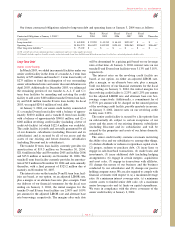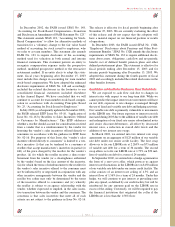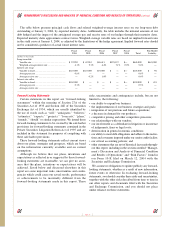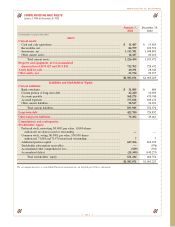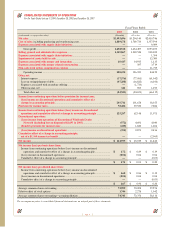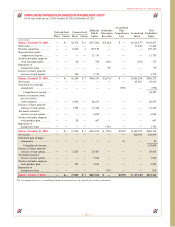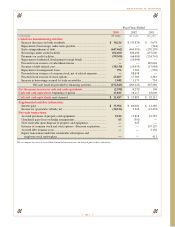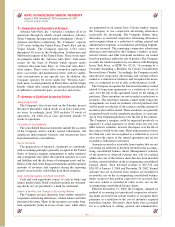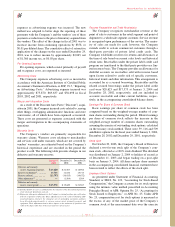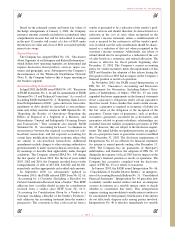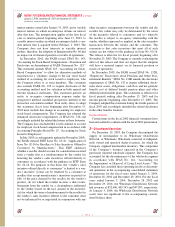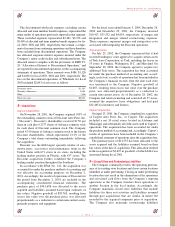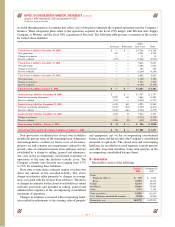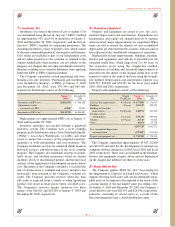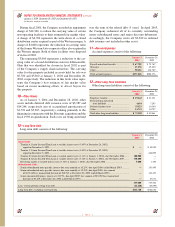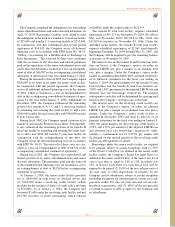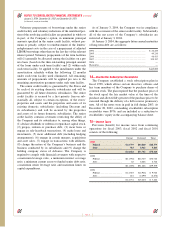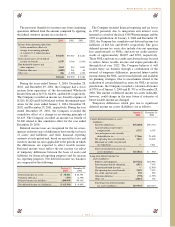Advance Auto Parts 2003 Annual Report Download - page 31
Download and view the complete annual report
Please find page 31 of the 2003 Advance Auto Parts annual report below. You can navigate through the pages in the report by either clicking on the pages listed below, or by using the keyword search tool below to find specific information within the annual report.
expenses as advertising expense was incurred. The new
method was adopted to better align the reporting of these
payments with the Company’s and the vendors’ use of these
payments as reductions to the price of inventory acquired from
the vendors. The effect of the change in fiscal 2001 was to
increase income from continuing operations by $358, or
$0.01 per diluted share. The cumulative effect of retroactive
application of the change on the year ended December 29,
2001, was to reduce income by approximately $2,065, net
of $1,360 income tax, or $0.03 per share.
Pre-Opening Expenses
Pre-opening expenses, which consist primarily of payroll
and occupancy costs, are expensed as incurred.
Advertising Costs
The Company expenses advertising costs as incurred in
accordance with the American Institute of Certified Public
Accountant’s Statement of Position, or SOP, 93-7, “Reporting
on Advertising Costs.” Advertising expense incurred was
approximately $75,870, $69,637 and $56,698 in fiscal
2003, 2002 and 2001, respectively.
Merger and Integration Costs
As a result of the Discount Auto Parts (“Discount”) acqui-
sition in 2001, the Company incurred costs related to, among
other things, overlapping administrative functions and store
conversions, all of which have been expensed as incurred.
These costs are presented as expenses associated with the
merger and integration in the accompanying statements of
operations.
Warranty Costs
The Company’s vendors are primarily responsible for
warranty claims. Warranty costs relating to merchandise
and services sold under warranty, which are not covered by
vendors’ warranties, are estimated based on the Company’s
historical experience and are recorded in the period the
product is sold. The following table presents changes in our
defective and warranty reserves.
January 3, December 28, December 29,
2004 2002 2001
Defective and warranty
reserve, beginning of period
... $ 15,620 $ 21,587 $ 18,962
Reserves established
(1)
............... 13,755 11,632 15,713
Reserves utilized
....................... (13,797) (16,015) (14,672)
Other adjustments
(2)
.................. —(1,584) 1,584
Defective and warranty
reserve, end of period
............ $ 15,578 $ 15,620 $ 21,587
(1) Includes $1,656 of reserves established for the transition of the discontinued operations
of the wholesale distribution network.
(2) Represents subsequent adjustments to the Company’s original purchase price allocation
from the acquisition of Discount. These adjustments were the result of obtaining addi-
tional information related to the estimated costs of outstanding warranties and have
been allocated proportionately to our non-current assets, primarily property and
equipment. These adjustments had no direct impact on the statement of operations, but
reduced the depreciable base of the associated non-current assets.
Revenue Recognition and Trade Receivables
The Company recognizes merchandise revenue at the
point of sale to customers in the retail segment and point of
shipment to a wholesale segment customer. Service revenue
is recognized upon performance of the service. The major-
ity of sales are made for cash; however, the Company
extends credit to certain commercial customers through a
third-party provider of private label credit cards. The
Company establishes reserves for returns and allowances at
the time of sale based on current sales levels and historical
return rates. Receivables under the private label credit card
program are transferred to the third-party provider on a lim-
ited recourse basis. The Company provides an allowance for
doubtful accounts on receivables sold with recourse based
upon factors related to credit risk of specific customers,
historical trends and other information. This arrangement is
accounted for as a secured borrowing. Receivables and the
related secured borrowings under the private label credit
card were $20,623 and $17,575 at January 3, 2004 and
December 28, 2002, respectively, and are included in
accounts receivable and other current liabilities, respec-
tively, in the accompanying consolidated balance sheets.
Earnings Per Share of Common Stock
Basic earnings per share of common stock has been
computed based on the weighted-average number of com-
mon shares outstanding during the period. Diluted earnings
per share of common stock reflects the increase in the
weighted-average number of common shares outstanding
assuming the exercise of outstanding stock options, calculated
on the treasury stock method. There were 59, 116 and 509
antidilutive options for the fiscal years ended January 3, 2004,
December 28, 2002 and December 29, 2001, respectively.
Stock Split
On October 29, 2003, the Company’s Board of Directors
declared a two-for-one stock split of the Company’s com-
mon stock, effected as a 100% stock dividend. The dividend
was distributed on January 2, 2004 to holders of record as
of December 11, 2003 and began trading on a post-split
basis on January 5, 2004. All share and per share amounts
in the accompanying consolidated financial statements have
been restated to reflect the effects of the stock split.
Employee Stock Options
As permitted under Statement of Financial Accounting
Standard, or SFAS, No. 123, “Accounting for Stock-Based
Compensation,” the Company accounts for its stock options
using the intrinsic value method prescribed in Accounting
Principles Board, or APB, Opinion No. 25, “Accounting for
Stock Issued to Employees,” or APB No. 25. Under APB
No. 25, compensation cost for stock options is measured as
the excess, if any, of the market price of the Company’s
common stock at the measurement date over the exercise
Page 29
Advance Auto Parts, Inc. and Subsidiaries


